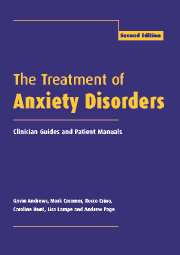Book contents
- Frontmatter
- Contents
- List of authors
- Preface to the second edition
- Abbreviations
- 1 Read me
- 2 General issues in anxiety disorders
- 3 General issues in treatment: Clinician Guide
- 4 Panic disorder and agoraphobia: Syndrome
- 5 Panic disorder and agoraphobia: Treatment
- 6 Panic disorder and agoraphobia: Clinician Guide
- 7 Panic disorder and agoraphobia: Patient Treatment Manual
- 8 Social phobia: Syndrome
- 9 Social phobia: Treatment
- 10 Social phobia: Clinician Guide
- 11 Social phobia: Patient Treatment Manual
- 12 Specific phobias: Syndrome
- 13 Specific phobias: Treatment
- 14 Specific phobias: Clinician Guide
- 15 Specific phobias: Patient Treatment Manual
- 16 Obsessive-compulsive disorder: Syndrome
- 17 Obsessive-compulsive disorder: Treatment
- 18 Obsessive-compulsive disorder: Clinician Guide
- 19 Obsessive-compulsive disorder: Patient Treatment Manual
- 20 Generalized anxiety disorder: Syndrome
- 21 Generalized anxiety disorder: Treatment
- 22 Generalized anxiety disorder: Clinician Guide
- 23 Generalized anxiety disorder: Patient Treatment Manual
- 24 Posttraumatic stress disorder: Syndrome
- 25 Posttraumatic stress disorder: Treatment
- 26 Posttraumatic stress disorder: Clinician Guide
- 27 Posttraumatic stress disorder: Patient Treatment Manual
- 28 Conclusions
- References
- Index
3 - General issues in treatment: Clinician Guide
Published online by Cambridge University Press: 05 August 2016
- Frontmatter
- Contents
- List of authors
- Preface to the second edition
- Abbreviations
- 1 Read me
- 2 General issues in anxiety disorders
- 3 General issues in treatment: Clinician Guide
- 4 Panic disorder and agoraphobia: Syndrome
- 5 Panic disorder and agoraphobia: Treatment
- 6 Panic disorder and agoraphobia: Clinician Guide
- 7 Panic disorder and agoraphobia: Patient Treatment Manual
- 8 Social phobia: Syndrome
- 9 Social phobia: Treatment
- 10 Social phobia: Clinician Guide
- 11 Social phobia: Patient Treatment Manual
- 12 Specific phobias: Syndrome
- 13 Specific phobias: Treatment
- 14 Specific phobias: Clinician Guide
- 15 Specific phobias: Patient Treatment Manual
- 16 Obsessive-compulsive disorder: Syndrome
- 17 Obsessive-compulsive disorder: Treatment
- 18 Obsessive-compulsive disorder: Clinician Guide
- 19 Obsessive-compulsive disorder: Patient Treatment Manual
- 20 Generalized anxiety disorder: Syndrome
- 21 Generalized anxiety disorder: Treatment
- 22 Generalized anxiety disorder: Clinician Guide
- 23 Generalized anxiety disorder: Patient Treatment Manual
- 24 Posttraumatic stress disorder: Syndrome
- 25 Posttraumatic stress disorder: Treatment
- 26 Posttraumatic stress disorder: Clinician Guide
- 27 Posttraumatic stress disorder: Patient Treatment Manual
- 28 Conclusions
- References
- Index
Summary
Effective treatments for the anxiety disorders are reviewed in this book. Some treatments – the cognitive behavioral therapies (CBTs) for the major anxiety disorders – are described in considerable detail. The background to the principal cognitive behavioral techniques will be described in this chapter, together with the clinical issues that are important if clinicians are to convert this group of techniques into an effective treatment.
Cognitive behavioral techniques
In Chapter 2 we presented a model of anxiety in which current adverse life events or mental images of adverse events would cause a person to appraise the events for threat. If the decision was that the event, real or imagined, would be an unpredictable and uncontrollable threat, then the level of neuroticism moderated the extent of the arousal and the symptoms experienced. Once threatened and aroused, the individual had two tasks, to take control to ensure that anxiety was facilitating not debilitating, and to take control over strategies to negate the threat. The problem is that most people with high neuroticism quickly decide that threats, being unpredictable and uncontrollable, are unmanageable. Treatment should make most threats understandable and controllable. Dearousal strategies such as hyperventilation control, and to a lesser extent, meditation and relaxation, are methods to limit arousal. Graded exposure, either to symptoms of the disorder or to phobic situations, is the key to limiting arousal and mastering avoidance. Cognitive therapy is focused on the appraisal process: ‘Is this event or predicament really a threat?’. Structured problem solving is about defining the threat or problem in such a way that solutions to some or all of the threat can be attempted and the problem, no longer uncontrollable, can gradually be mastered. Skilled therapists can help patients to recover by using only one of these techniques, say cognitive therapy or graded exposure, but most of us are pleased to use all four, albeit modified for the particular anxiety disorder. Marks (see Marks and Dar, 2000), once a strong proponent of exposure therapy, has argued that fear reduction is possible by all of the above techniques.
Dearousal strategies
Hyperventilation control
Breathing more deeply than is normal is part of the normal physiological response to threat.
- Type
- Chapter
- Information
- The Treatment of Anxiety DisordersClinician Guides and Patient Manuals, pp. 24 - 35Publisher: Cambridge University PressPrint publication year: 2002



